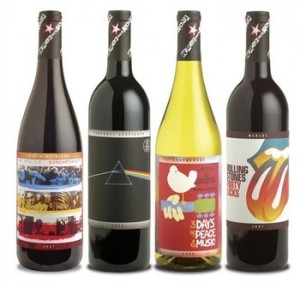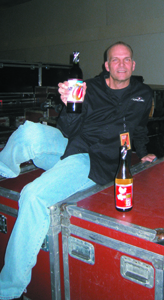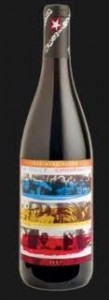Wines That Rock: Cultivating Inspiration, Music and Marketing Zen
MIDTOWN, MANHATTAN: Sometimes a winning idea is pure as the driven snow, and other times it’s a more complex combination. The progress of NYC-based Wines That Rock shows that a great music business concept only requires one simple spin on the obvious to get ahead.
Launched in 2009, Wines That Rock didn’t just inject more alcohol into the marketplace. Instead, they put their finger on something that people were really ready for, creating music-inspired wines that resulted in three initial rock varietals: Rolling Stones “Forty Licks” Merlot, “Woodstock” Chardonnay, and Pink Floyd “The Dark Side of the Moon” Cabernet Sauvignon. Most recently, a Police “Synchronicity” blend has entered the mix.
File under: “Why didn’t we think of that?” Each wine – crafted by the sustainable Mendocino Wine Company winemaker Mark Beaman – features the album’s iconic art (or the Woodstock 40th Anniversary poster), and plays off an entirely different dimension of emotional appeal than your typical bottle of vino. Like wine and food, wine and music is a prime pairing – the difference is that the latter remains largely unexplored.
As you might suspect, Wines That Rock had some connections and experience to make the idea take flight. One of the primary partners is NYC’s RZO Interactive, a division of the rock business management firm RZO that represents The Rolling Stones, David Bowie, U2, Sting and The Police. Along with Bowie, RZO created the first online fan club company in UltraStar Entertainment, which grew to over 30 artist online fan clubs and was eventually sold to Live Nation — in turn, a core group of UltraStar founders are the creative force behind Wines That Rock.
Get the picture? These are people that understand music and how to execute a business plan. Wines That Rock Co-founder/Partner Ron Roy spells out here how to grow your gestalt, and then make the market flow in your direction.
How did the Wines That Rock concept come about?
One day I was sitting at the kitchen table with some baseball cards and listening to the Flaming Lips. I said, “Wouldn’t it be cool to loop this glass of wine into something that connects the music to me? If I saw the “Dark Side of the Moon” album cover on a wine bottle, I’d go check it out.
In Wines that Rock, my partners and I are from the music industry. We started UltraStar Entertainment in the ’90, and were a ticketing technology company that provided fan clubs with a VIP experience – we represented the Rolling Stones, the Red Hot Chili Peppers, David Bowie among others. It was eventually sold to Live Nation in 2005.
We’re entrepreneurs at heart, always trying to come up with some interesting things. I said, “How about this? We know we can get to the artist. So what if we could find a winery who would believe in what we’re doing, and challenge them to make an interpretation of what “Dark Side of the Moon” means, making a custom-crafted wine to put in the bottle.”
That sounds like a deceptively simple concept.
It’s traditional to make wines that pair well with food. But if you think about pairing music and wine, music is everywhere – romantic dinners at a restaurant, in a bar, on TV via commercials and film soundtracks. Even though music is part of a lifestyle that people project, no one was really taking a serious look at music and wine. So there’s an opportunity there. Last year there were 100,000 different wines available. That’s a crowded market – I don’t want to play in that sandbox with a normal wine company.
We wanted to look at it as part of an experience. When people bring these wines to parties, or when we do tastings or events, the stories just come out like crazy when they see the labels. “I saw the Stones in ’95,” “I had Pink Floyd posters in my dorm room,” “My uncle went to Woodstock.” Our wines tell these amazing stories of people, and it brings out this whole social atmosphere.
How are you picking what albums to design a wine around?
We wanted a good variety, and we look at a number of things when making this decision. To start with, we wanted to pick amazing albums, and then you also have to put your marketing hat on.
Dark Side of the Moon has sold 50,000,000 copies worldwide – it’s such an iconic album and everyone knows that album cover. Cabernet sauvignon is the best selling varietal, so when we talked to our winemaker, Mark Beaman, we told him to be experimental with it – you can do a lot with cabernet. Meanwhile, the Rolling Stones’ biggest touring album, 40 Licks, is the only album with the tongue-and-lip artwork, and that’s one of the most recognizable images in rock. We wanted to bring out what the Stones are all about – the big, complex, heaviness of the music – and so that’s why we chose to make it a merlot.
Our winery in Mendocino County is one of the most sustainable. We won the Governor’s Economic and Environmental Leadership Award two out of the last three years, so we wanted something that presented sustainability and the Earth. When we looked at the Woodstock poster we said, “Let’s bring the whole philosophy of what Woodstock is about through the farms of Mendocino.” The result is this 2008 chardonnay.
For Synchronicity, that was interesting. Our first three wines are all varietals, but red blends are hot. We wanted something unique and different, and the word “synchronicity” kept sticking with us – bringing all these events together, and somehow they work. Mark sold us on taking several grapes that typically aren’t matched together. UltraStar worked with Sting, it’s an iconic album cover, and we thought it would be different to do something from the New Wave environment. That all added up, and when our winemaker gets excited he makes something interesting.
So once the wine is conceptualized, what kind of business arrangement has to be worked out with the artist?
For our first three launches, it’s about going to them, partnering with them and saying, “Let’s work together and make this a success: great music, and great wine in the bottle.” The fan base of bands like Pink Floyd and the Rolling Stones are the wheelhouse for our demographic. They have their fan clubs, email lists, Websites, and we work together as partners — they send out a nice newsletter announcing the wine, for example. In another initiative, we’ve just launched a contest with Wine Enthusiast magazine giving away a guitar signed by Sting. All of these bands or events have been brands for 40 years, and they have a following.
Then there’s our past history with UltraStar, and one of my partners has the management firm RZO that produced the Reunion Tour of the Police – that made it easier in the case of Synchronicity. When we went to the Police we said, “We’ve been out there a year now. We’ve had great success and wide distribution, done well at the varietal level, got great press, and we’re ahead of our projections.”
It all gets back to Marketing 101. We wanted to make this a partnership, doing cooperative marketing with the band. We coordinate with the Police, Pink Floyd and Rolling Stones marketing, and that’s the model we take to our bands and their partners.
It’s obviously a very smart approach to getting a music-related idea off the ground. If someone is reading this and they’re inspired, how would you suggest that they come up with their own winning concept?
I teach entrepreneurial studies, and I tell my students every semester, “It’s so difficult to be 100% unique, and have a purely organic idea that no one else has touched in some way.” But if you can come up with an original idea, also bring in a proven idea, and look at the big picture, you might develop a hit.
Looking at Wines that Rock as an example, the wine industry is a $70 billion industry, with 100,000 different wines on the market. So our question was, “How do I get myself some of that shelf space? How can we stick out in this crowded industry?” There’s so much room in the music industry to come up with a unique idea, you just have to find it.
My favorite term in the class is, “What’s the secret sauce?” For example, if you have a mobile technology and it somehow intertwines with music, what are you putting out there that another company isn’t doing? There’s a lot of ways to skin it, so really look at what’s successful, and then look for an opening that you can prove no one else is doing. No one was doing a custom wine based on the experience of an album and a label – that I could prove when we were conceptualizing Wines That Rock.
The great thing about music is that there’s new product all the time, especially from a technologically standpoint. There are companies that have made a fortune building a widget. The idea doesn’t have to stand alone or be self-supporting – it can converge with something that’s already out there. So what’s your secret sauce?
— David Weiss
Please note: When you buy products through links on this page, we may earn an affiliate commission.










Carolyn C
July 26, 2011 at 9:05 pm (14 years ago)A great article on a great idea. Wines that Rock really are as good as the music which they embody, an impressive feat to accomplish. HUGE fan of the product!